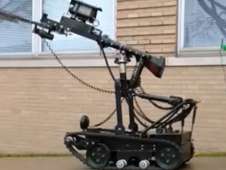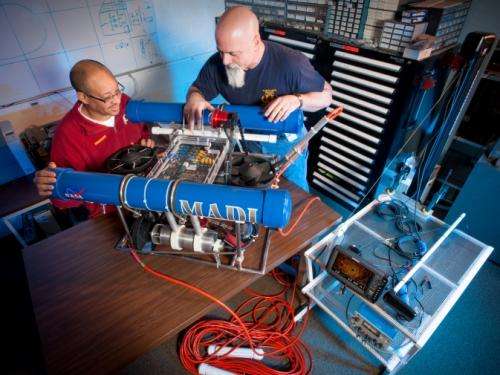Designing robots for Earth and space

In a remote corner of the Cleveland Police Museum, a famous robot languished gathering dust. In its glory days, this robot was part of the fight in the 1970s against Mafia domination in Cleveland.
As the bombing capital of the country at the time, the robot known as Leroy was a crime-fighting superstar, taking dozens of unexploded bombs away from neighborhood targets and depositing them in safe containers for detonation.
When the Mafia was eventually broken by local and federal law enforcement, Leroy's role waned and he was consigned to a corner of the museum.
A few months ago, NASA Glenn Senior Research Engineer Mike Krasowski was visiting the museum and had a conversation with Bob Cermak, museum volunteer and trustee. When Cermak expressed an interest in refurbishing Leroy, Krasowski assured him that the center's Mobile and Remote Sensing Lab (MARS) could get the robot working again under an existing Space Act Agreement with the City of Cleveland.
Along with engineer Larry Greer and technician Danny Spina, the MARS team fitted Leroy with new electronics and capabilities. He might be a 1970s robot, but today he is fitted with technology that allows him to be operated remotely by computer or tether, take still and video camera images, operate a vintage police shotgun and operate the bomb gripper.
"Thanks to the folks at Glenn, we can now use Leroy to educate the public," says Cermak. "Kids can operate the robot to better understand the tools we used for crime fighting in that era."

While the MARS team helped the Cleveland Police refurbish an old crime-fighting robot, their day-to-day work involves outfitting modern robots for other applications for first responders under the Space Act Agreement, which has great potential for science in space and on Earth. For example, they are currently working on the instrumentation of MADI (the Mars Lab Aquatic Descent Instrument). It's an underwater robotic device fitted with interfaces for sensors and instruments for applications in law enforcement and underwater science in fresh and salt water.
"The beauty of MADI is that it can be tailored to meet the needs of any underwater mission," says Krasowski. "If first responders want to use it, we can fit the robot with metal detectors and sonar imaging equipment to locate underwater evidence in the murky depths of Lake Erie."
Diving is always dangerous and many first responder divers are injured each year. A robot like MADI, outfitted with specialized sensors, can dive into the water first and search an underwater scene, keeping humans out of harm's way. Then if a diver is needed, the diver can follow MADI's tether down to an area of interest.
The MARS team is also working with freshwater research scientists at Glenn investigating the health of lakes and streams in the Midwest. "In that situation," says Krasowski, "MADI can be fitted with sensors that measure pressure and temperature; water salinity and chemical compounds, just to name a few."
At the heart of MADI is a complex operating system. Greer has developed the "brains" of the robot, which allows it to operate and send critical data to remote computers for analysis.
The MARS team will be working with the Cleveland Police and NASA researchers through 2014 to test and demonstrate MADI's capabilities. But they already have a group of believers. This summer, students from Glenn's Space Academy were given an educational challenge to design instruments for underwater exploration. Krasowski's team used MADI to test their ideas by attaching instruments and lowering the robot into a quarry descending 90 feet. It gathered data used by the students to write their reports. They went home excited about scientific research.
Beyond Earth, the team believes MADI could be a research tool on celestial bodies such as Titan. One of the moons orbiting Jupiter, Titan has many lakes of liquid methane. "In astrobiology, we are always looking for biomarkers or biosignatures, which point to signs of life," says Krasowski. "Scientists developing submersible instruments for Titan lake science missions can proof instruments using MADI to perform underwater tests and demonstrations on Earth."
Provided by NASA





















